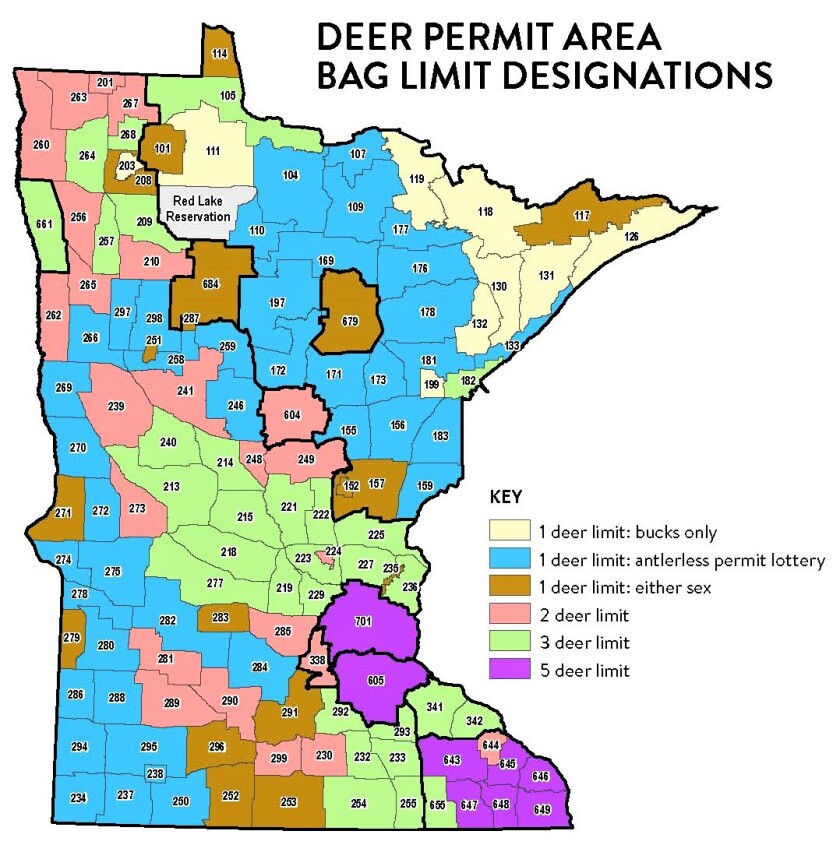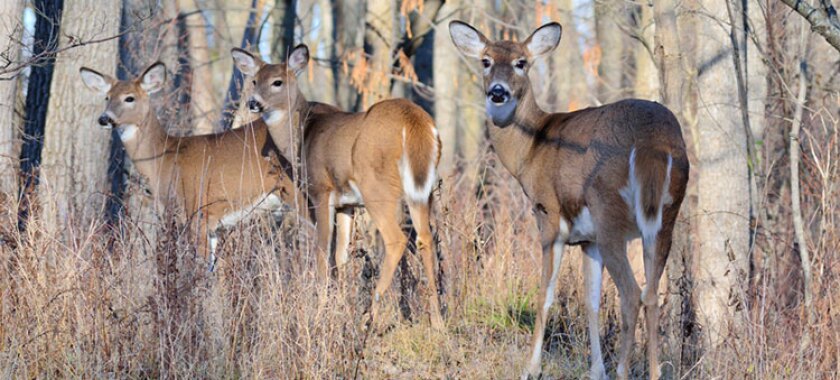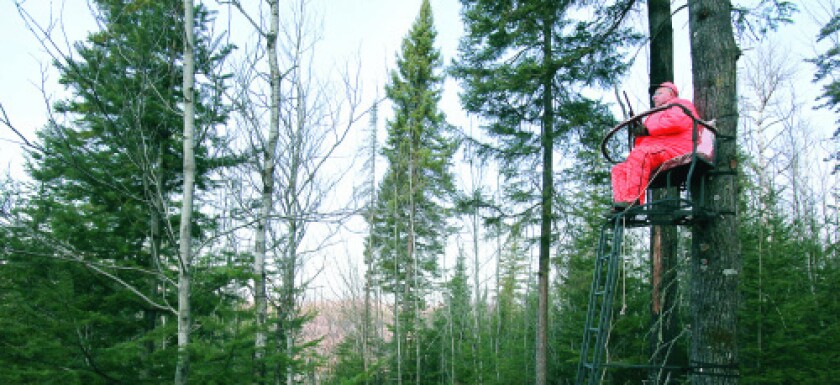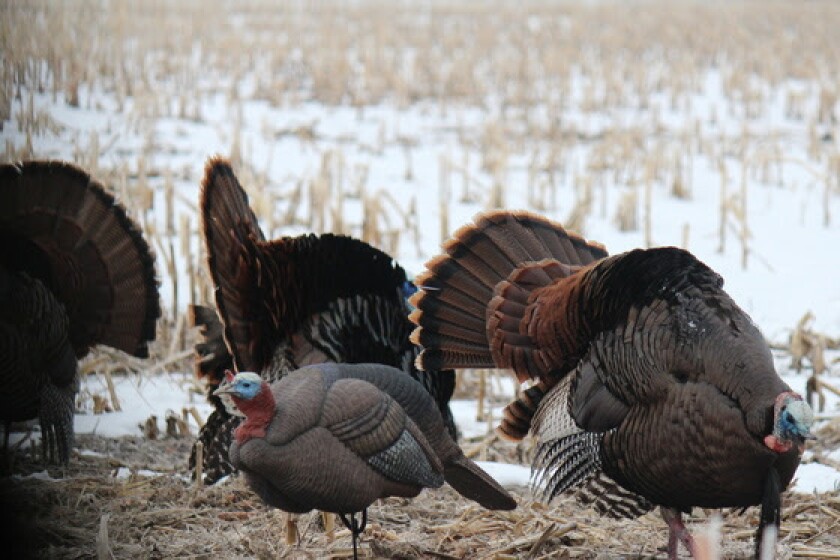ST. PAUL — Deer hunters across northern Minnesota have braced for the news since the last snow finally melted in April, and the Minnesota Department of Natural Resources has now confirmed it: fewer doe permits and more bucks-only hunting this fall after yet another deep-snow winter.
DNR wildlife officials on Tuesday announced details of the 2023 statewide firearms and archery deer hunting seasons, with fewer northern deer management units offering multiple deer or hunter’s-choice options and more units requiring a lottery doe permit or allowing only bucks to be shot.
ADVERTISEMENT
Doe permits available across the 100-numbered deer management units are down 43% from last year, from 7,625 to 4,325. The doe permits available this year in the region will be just a fraction of the roughly 18,000 available in 2012, before the string of snowy winters hit.
If your unit offers lottery doe permits the deadline to buy a license and be included in the lottery is Sept. 7.

The firearms deer season will begin Nov. 4 and run through Nov. 19 in the 100-acre units that includes all of Northeastern Minnesota. The 200-units season runs Nov. 4-12 with the 300-units season from Nov. 4-12 and again Nov. 18-26. The muzzleloader season runs from Nov. 25 to Dec. 10.
Kelly Straka, DNR wildlife section leader, urged all hunters to double-check what deer management unit they hunt in to see if restrictions have changed from last season, including requiring doe permits in areas where hunters recently have had the option to shoot any deer.
DNR biologists said Tuesday they continue to place emphasis on battling back against chronic wasting disease, including several new programs and efforts funded by the 2023 Minnesota Legislature. All deer management units that begin with the number 6 are considered a CWD surveillance zone with restrictions against feeding deer at any time of year, a ban on the use of deer attractants and special requirements for having deer tested. All deer shot over opening weekend must be tested. (Deer baiting when hunting remains illegal in all areas and seasons.)
The DNR also is testing deer near the state’s northwestern elk herds to see if CWD exists in areas where elk frequent in advance of a plan by the Fond du Lac Band of Lake Superior Chippewa to move some of those elk to eastern Minnesota in coming years. So far no Minnesota wild elk have tested positive for CWD.
I think in your part of the state we need multiple years of mild winters paired with lower bag limits for deer populations to recover.
Statewide, deer numbers are generally expanding in many central and southeastern areas, holding their own in some areas and declining in the northeast. Some 38 units statewide saw reduced doe or antlerless permits issued with 80 units the same as 2022 and 12 units in the central part of the state with increased doe permits available.
ADVERTISEMENT

Barb Keller, big-game program specialist for the DNR, said she expects this fall’s deer harvest in northern Minnesota will be down from recent years “and that’s somewhat by design, we want to allow deer populations to recover.” But because the actual harvest varies widely depending on weather during the season, many hunters could still bag their bucks if conditions are good, and that “might make up” for fewer doe permits being issued, she added.
But in many areas of far northern Minnesota there are simply fewer deer out there to be seen or shot.
“I think in your part of the state we need multiple years of mild winters paired with lower bag limits for deer populations to recover,” Keller said.
Most of Minnesota’s Arrowhead region will be bucks-only this year with other areas offering reduced antlerless or doe permits by lottery. The exceptions are the Boundary Waters Canoe Area Wilderness, where hunters can shoot either a doe or buck, and in the immediate Duluth area where hunters can again take up to three deer to help reduce the burgeoning urban deer population.
Many northern deer management units saw their available doe permits cut in half or more. In management unit 171 south of Grand Rapids, for example, the number of doe permits was cut from 1,500 last year to 250 this year, with doe permits cut from 2,000 to 500 in unit 172.

The deep-snow winter of 2022-23 — the seventh out of the last 10 years with well above average snowfall in some areas — impacted white-tailed deer in Northeastern Minnesota, especially north of Duluth, with some deer perishing outright due to the conditions and nutrition-stressed does having fewer fawns this spring. Duluth saw an all-time record 140.1 inches of snow last winter, with even more snow in some locations to the north and east. Not only do more deer succumb to the elements during those deep snow winters, but they also become more vulnerable to predation by wolves.
Because there are fewer deer on the landscape in the Arrowhead, and fewer than goals set by the Minnesota Department of Natural Resources, the agency has imposed conservative harvest rules again this year. Because they can’t control the weather, controlling how many does are shot each year is the primary tool for DNR wildlife managers seeking to either build or reduce the local deer population. Because does often have two and even three fawns when conditions are good, the population can rebound fast, as it did 25 years ago after harsh winters in the mid-1990s.
ADVERTISEMENT
The northwoods are a tough place for deer. Biologists note that basic nutrition is simply better for deer in areas with a mix of woods and fields, and especially where agricultural crops are available. Short of corn and oats, the next best thing for deer is a young forest with many edges and openings. Deer do not do well in thick, older northern forests. (In fact, deer weren't present in northern Minnesota forests until after extensive logging began.)
The deadline to apply for the special archery hunts, the Camp Ripley archery hunt and special youth hunts is Aug. 18. Archery season begins Sep.16. This year’s statewide youth firearms season will be Oct. 19-22, with no special permit needed.
For more information on this fall’s various deer season, special hunts, youth hunts and more hunting season details go to . Paper copies of the 2023 fall hunting synopsis are delayed and won't be available at license agents until later in August.
New for 2023
- Any hunter who purchases an archery deer license may take deer with a crossbow throughout the archery deer season. In the past it was only elderly and hunters with disabilities. The change was ordered by the 2023 Legislature. DNR officials said they expect to see a gradual shift to more crossbow hunters, with fewer bow hunters and fewer firearms hunters, but not an overall increase in total deer harvested because of the change.
- Deer permit area 343 is now 643, deer permit area 344 is now 644 and deer permit area 184 is now 684. All have been added to the CWD management zone.
- Hunters using ground blinds on public lands must have a blaze orange strip of material on the blind.
- Members of a hunting party may not tag a legal buck or antlerless deer for any member of their party hunting with a youth license.
- Portable deer stands may be left overnight in certain wildlife management areas in Northwestern Minnesota.
- A licensed hunter who lawfully harvests an escaped farmed deer or elk is not liable to the owner, but they must notify the DNR within 24 hours. If you harvest a deer or elk with ear tags or other identification, contact a conservation officer.
- Hunters may only possess and use nontoxic ammunition when participating in a special hunt or disease management hunt in a Minnesota state park or Scientific and Natural Area or in a regular hunt in a Scientific and Natural Area in which hunting is allowed. Youth hunters in the shotgun zone are exempt from the rule.
- The state’s shotgun-only deer hunting zone remains in place, no changes have been made.



















